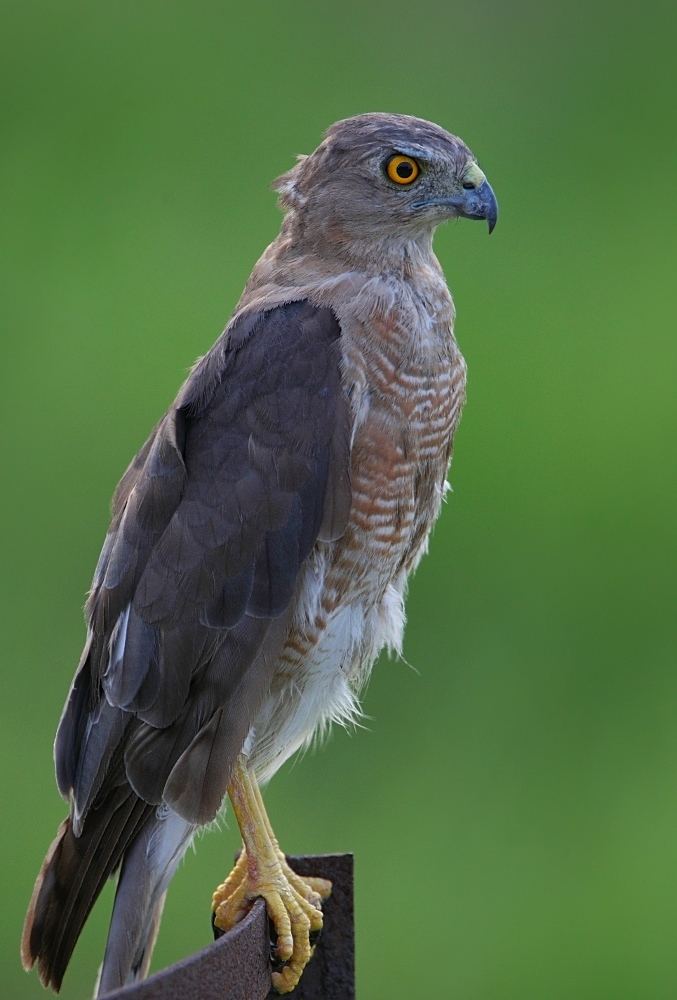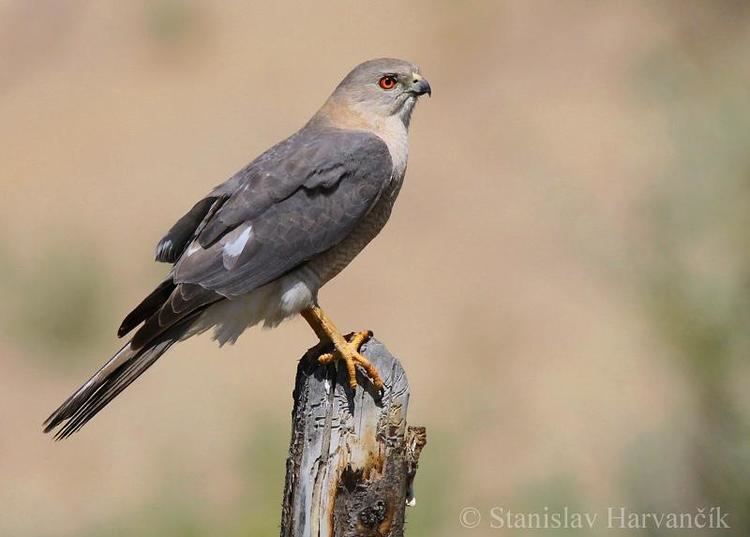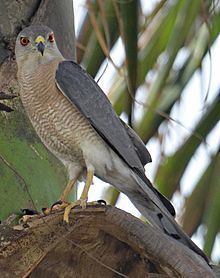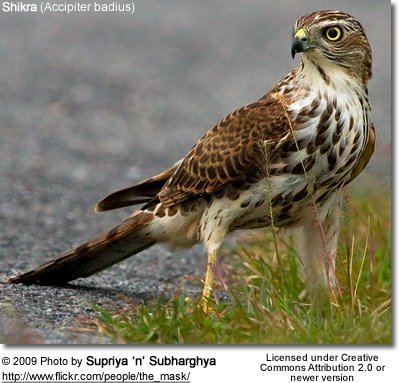Higher classification Accipiter | Phylum Chordata Scientific name Accipiter badius Rank Species | |
 | ||
Similar Bird, Accipiter, Besra, Red‑wattled lapwing, Drongo | ||
The shikra (Accipiter badius) is a small bird of prey in the family Accipitridae found widely distributed in Asia and Africa where it is also called the little banded goshawk. The African forms may represent a separate species but have usually been considered as subspecies of the shikra. The shikra is very similar in appearance to other sparrowhawk species including the Chinese goshawk and Eurasian sparrowhawk. They have a sharp two note call and have the typical flap and glide flight. Their calls are imitated by drongos and the common hawk-cuckoo resembles it in plumage.
Contents

Shikra
Identification

The shikra is a small raptor (26–30 cm long) and like most other Accipiter hawks, this species has short rounded wings and a narrow and somewhat long tail. Adults are whitish on the underside with fine rufous bars while the upperparts are grey. The lower belly is less barred and the thighs are whitish. Males have a red iris while the females have a less red (yellowish orange) iris and brownish upperparts apart from heavier barring on the underparts. The females are slightly larger. The mesial stripe on the throat is dark but narrow. In flight the male seen from below shows a light wing lining (underwing coverts) and has blackish wing tips. When seen from above the tail bands are faintly marked on the lateral tail feathers and not as strongly marked as in the Eurasian sparrowhawk. The central tail feathers are unbanded and only have a dark terminal band. Juveniles have dark streaks and spots on the upper breast and the wing is narrowly barred while the tail has dark but narrow bands. A post juvenile transitional plumage is found with very strong barring on the contour feathers of the underside. The call is pee-wee, the first note being higher and the second being longer. In flight the calls are shorter and sharper kik-ki ... kik-ki. The Chinese sparrowhawk is somewhat similar in appearance but has swollen bright orange ceres and yellow legs with the wing tips entirely black.
Taxonomy and systematics

Several subspecies are recognized across its range and some of them may be treated as full species. It has been suggested, based on differences in morphology and calls, that the African forms do not belong to this species. Subspecies cenchroides (Severtzov) is larger and paler and found in Turkestan, Afghanistan and eastern Iran. The Indian population dussumieri is resident on the plains and lower hills (up to 1400 m in the Himalayas). The nominate form is found in Sri Lanka and has somewhat darker grey upperparts. The Burmese shikra A. b. poliopsis may represent a distinct species. The population on Car Nicobar Island, earlier treated as a subspecies butleri and that on Katchall Island, obsoletus are now treated as a sub-species within a full species, the Nicobar sparrowhawk (Accipiter butleri). The west African population A. b. sphenurus is migratory while the southern African A. b. polyzonoides is more nomadic in its movements. In Asia only A. b. cenchroides is migratory.
Ecology

The shikra is found in a range of habitats including forests, farmland and urban areas. They are usually seen singly or in pairs. The flight is typical with flaps and glides. During the breeding season pairs will soar on thermals and stoop at each other. Their flight usually draws alarms among smaller birds and squirrels. They feed on rodents (including Meriones hurrianae), squirrels, small birds, small reptiles (mainly lizards but sometimes small snakes) and insects. Small birds usually dive through foliage to avoid a shikra and a Small Blue Kingfisher has been observed diving into water to escape. Babblers have been observed to rally together to drive away a shikra. They will descend to the ground to feast on emerging winged termites, hunt at dusk for small bats (such as Cynopterus sphinx) and in rare instances they may even resort to feed on carrion. In one instance a male was found feeding on a dead chick at the nest. Their calls are mimicked by drongos and this behaviour is thought to aid in stealing food by alarming other birds that the drongos associate with.
The breeding season in India is in summer from March to June. The nest is a platform similar to that of crows lined with grass. Both sexes help build the nest, twigs being carried in their feet. Like crows, they may also make use of metal wires. The usual clutch is 3 to 4 eggs (when eggs are removed they lay replacements and one observer noted that they could lay as many as 7 in a season) which are pale bluish grey stippled on the broad end in black. The incubation period is 18 to 21 days.
In culture
The shikra was a favourite among falconers in India and Pakistan due to the ease with it could be trained and was frequently used to procure food for the more prized falcons. They were noted for their pluck and ability to take much larger birds including partrigdes, crows and even young peafowl. The word shikra or shikara means hunter in the Hindi language (the male was called chipak or chipka based on call) The word Shikra is borrowed from the Urdu word (شِـكْـره) which is derived from the word shikari (شِكارى) meaning hunter. Hunting in Persian and Turkish is referred to as shikar (شِـكار), and in Arabic the hunt master in the Mamlook Era was known as Ameer Shikar (أمير شِـكار). The word Shikari may also be used in English in the sense of "hunter". In "The return of Sherlock Holmes" by Arthur Conan Doyle, Sherlock Holmes says: "I wonder that my very simple stratagem could deceive so old a shikari" (The Penguin complete Sherlock Holmes, 1981, pp. 492, 494).
The word is also used in the French name Le Chicquera which was however given to the red-necked falcon by Levaillant in 1799.
An Indian Navy's helicopter base was named INS shikra in 2009.
The shikra is also the mascot for the 149 Squadron of the Republic of Singapore Air Force, which operates the F5S/T Tiger IIs fighter jets.
